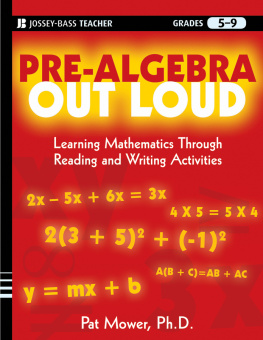All Math Words Dictionary
By David E. McAdams
Second Edition
Version 20140501
Copyright 2014 by Life is a Story Problem LLC, Colorado Springs, Colorado.
All rights reserved. This publication is protected by copyright, and permission must be obtained from the publisher prior to any prohibited reproduction, storage in a retrieval system, or transmission in any form or by any means, electronic, mechanical, photocopying, recording, or likewise. For information regarding permissions contact .
Life is a Story Problem LLC
2910 North Powers Suite 326
Colorado Springs, CO, 80922
Dedicated to the Math Department at Utah Valley University, Orem, Utah for their excellent teaching.
Table of Contents
Preface
All Math Words Dictionary is designed for students of pre-algebra, algebra, geometry, and intermediate algebra in middle school and high school. It is designed using the four 'C's of math writing:
- Concise: Definitions are compact, yet understandable.
- Complete: All words and phrases of interest to targeted students are included, plus a few just beyond the scope of the target classes. Tables of symbols and notation, formulas, and units of measurement, plus lists of properties of objects give the student all the information needed to weld their understanding of the concepts and decipher many problems.
- Correct: The definitions have been thoroughly reviewed for mathematical and literary correctness.
- Comprehensible: The definitions are written to be understood by targeted students. Abundant illustrations aid in understanding.
One of the difficulties many students experience in learning math skills has to do with the fact that an entire language, both spoken and written, has grown up around math. Students that acquire that language are successful in math studies. Students that do not acquire that language have serious problems with mathematics. This dictionary is designed to aid in the acquisition of the language of math.
This dictionary has:
- over 3000 entries
- more than 140 notations defined
- in excess of 790 illustrations
- IPA pronunciation guide
- greater than 1400 formulas, equations, definitions, examples, identities and expressions.
- conversion of measures
How to Use this Dictionary
This dictionary has alphabetized entries plus a subject index containing formulas and identities. Most entries are laid out like this:

At the end of the entry, there may be additional notes such as synonyms and references to related words or to the subject index.
The pronunciation in this dictionary is given in International Phonetic Alphabet (IPA) style. A brief guide to the portion of IPA used in the section .
Some words and phrases have more than one distinct meaning. In this case, there will be several enumerated definitions:
logic noun /ld.k/
- the science that investigates the principles governing correct and reliable inference.
- a series of statements that make use of the science of logic.
If pronunciations of a word for different definitions are different, the pronunciation will appear with each definition.
Multiple words with the same meaning are typically defined only once, with the less common usage referring to the main entry like this:
null set noun /nl st/ see .
Abbreviations and acronyms are given their own entry without a definition of the abbreviated word. An acronym is a set of letters that stand for a phrase, usually the first letter of each word in the phrase. You can look up the word once you know what the abbreviation stands for:
lcd abbreviation .
Entries describing elements of computer languages have computers for the part of speech and have no pronunciation, like this:
atan() computers
represents the arctangent function in many computer languages.
Prefix entries are similar to regular entries. Each prefix is followed by a hyphen. This tells the reader that the prefix is not a whole word, but is used to form other words:
delta- prefix /dl.t/
having to do with equilateral triangles.
If the plural of a word or phrase has an unusual spelling or pronunciation, that spelling and pronunciation appear at the end of the entry like this: Plural: series .
At the end of each definition there may be list of related words. Related words can be synonym, antonyms, or variants of each word. Also, external dynamic geometry applications can be accessed on many readers by clicking the GeoApp! link on many words.
There is a section with common math notation in the section . Since these symbols can not be alphabetized, they are grouped by category. Within each category they appear in no particular order.
How Entries are Alphabetized
There are several things which influence the alphabetization scheme of this dictionary:
- This dictionary defines many phrases in addition to single words.
- Numeric digits are part of some entry headings.
- Hyphens and commas appear in some entry headings.
- Mathematical symbols are used in some entry headings.
Because of these issues, a special alphabetization scheme is used.
- Capital letters are alphabetized the same as lower case letters. The following words are in the special alphabetical order:
- abacus
- Abelian group
- abscissa
- Spaces are ignored. The following words are in the special alphabetical order:
- amplitude
- analytical proof
- analytic geometry
- Numeric digits come before alphabetic letters and are in numeric order. The following entries are in the special alphabetical order:
- 1, property of multiplication by
- 2-space
- 3-space
- All punctuation marks such as commas and hyphens are ignored. The following entries are in the special alphabetical order:
- half
- half-angle
- half life
- half-line
Exception: In the case of a prefix, the entry with the dash comes after anyentries with the same letters but no dash, but before any words using that prefix.The following entries are in the special alphabetical order:
Conventional Plurals
The plurals (more than one) of nouns are shown at the end of an entry only if the spelling or pronunciation of the plural is unusual. The usual spelling of plurals are:
Conventional Plurals
Ending
Spelling
Pronunciation
Example
'se' (silent e)
'ses'
sz
inverse Plural: inverses /n'vr.sz/
's', 'x', or 'ch'
'ses'
sz
class Plural: classes /kl.sz/
'y'
'ies'
iz
identity Plural: identities /adn t tiz/
All others
's'
s or z
shift Plural: shifts /ftz/
IPA Pronunciation
Stress marks: // primary; // secondary

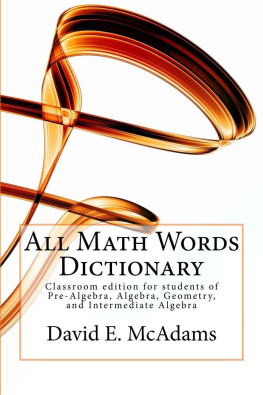

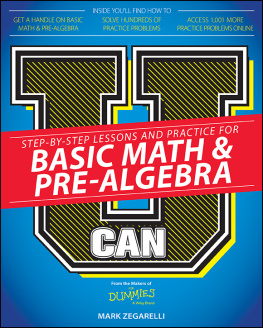

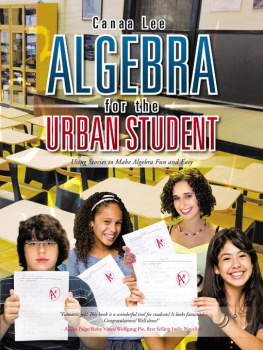

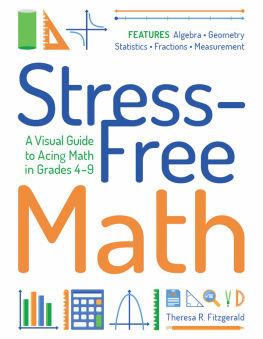
![Debra Anne Ross [Debra Anne Ross] - Master Math: Basic Math and Pre-Algebra](/uploads/posts/book/119083/thumbs/debra-anne-ross-debra-anne-ross-master-math.jpg)
